22 January, 2016
Tips On Cooking Vegetables and More
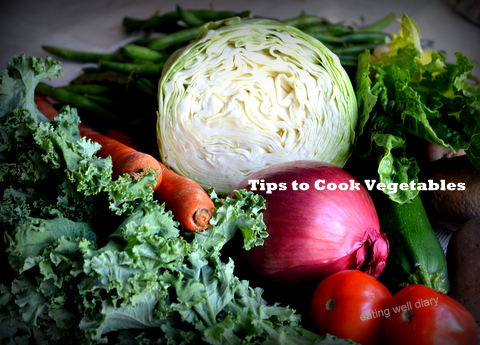
A friend of mine asked me pen my tips on cooking vegetables to maximize their nutrient benefit. I do not claim to be an expert on the subject, but have gained some knowledge through reading books and health blogs.
My blogger friends: please feel free to share your tips in comments below. I will update this post with your thoughts with due credit.
Organic/ Conventional Produce, To Peel or Not to Peel?
The rules and methods that I follow:
- Try to get organic root vegetables whenever possible, and if they are organic- do not peel them. Most common examples are potatoes, sweet potatoes, carrots.
- Other vegetables that are best to buy organic are bell peppers, green zucchini, broccoli, greens, etc. As a child I used to be disgusted when I found caterpillars inside a cauliflower. Yew. But now I’m excited to find them in the raw vegetable, because I know that it does not have much pesticides!
- A helpful chart is the famous “The Dirty Dozen and Clean Sixteen” list of produce. It can be found on the Environmental Working Group here. Also see this post by Dr. Andrew Weil.
How To Clean Produce
- Just a thorough wash or soaking in water mixed with a few drops of vinegar will clean them. Remove any sprouts from potatoes and any bruised portions on the skin.
- Use a vegetable cleaning brush to remove dirt.
Steaming vs. Saute vs. Deep Frying
It is a well-known fact that steaming is the best way to eat healthy. But who likes to eat only steamed veggies all the time? It would be boring!
Deep-frying:
- Most oils are inflammatory, meaning they can contribute to chronic illness and pain in the body. This includes vegetable oil which is mostly soy-derived, oils of canola, corn, sunflower.
- High temperatures (ideally 350 -375 °F) used for deep-frying can release acrylamide andfree radicals that destroy nutrient value of food. It is no doubt the tastiest, but it is very difficult to maintain the temperature of hot oil in a pot.
- That being said, occasional deep-frying, about once a month may be fine, as long as the right type of oil is used.
- Health experts recommend oils containing:
1. saturated fat- like coconut oil (see this post) that does not get damaged at high temperatures. Personally, I find that coconut oil froths up while deep frying, so one needs to use a deep vessel.
2. high amount of mono-unsaturated fats like olive oil (not extra virgin) and avocado oil. Since olive oil has a strong flavor, avocado or sometimes grape seed oil is preferred for neutral flavor.
My trick: I always buy organic, expeller pressed oils that are healthy but cost 3 times the price of other oils. That way, I do not want to waste my money by using large amounts for deep frying. That very thought makes me look for alternatives!
Alternatives to deep-frying to reduce the amount of oil are
- USING an Appe/ Aebleskiver pan. Go for the ones made without non-stick coating.
- BAKING: Learning to embrace my oven has been the best change I made in my cooking journey.
You can limit the oil consumption to just 1/2 – 1 tsp. per each deep fried piece of food!
Saute:
Most Indian cooking begins with a saute of spices in oil. The trick to making it healthier is to:
- use only 1-2 tsp. of the right type of oil or ghee (clarified butter).
- adding vegetables early to the saute prcoess after tadka or tempering. This maintains a lower temperature.
- I like to close the pot during the saute process so that the steam that escapes from the sauteed vegetables stays in the vessel and assists in the cooking process to make it faster. It also resembles steaming.
Which material Should My Cookware Be Made Of?
The safest are stainless steel (pots and pans), cast-iron (flat ware or kadai) and ceramic-coated cookware.
Non-stick coating which used to be very popular is not recommended any more since the coating (PFOA) is carcinogenic and leaches into food.
Aluminum is a known neurotoxin. It is best to avoid aluminum pans. I even refrain from baking directly on an aluminum sheet or foil. It is especially dangerous to cook acidic foods (lemon, tamarind, yogurt base) in it as the metal dissolves more in acidic medium.
Microwave Cooking
There are different theories out there about this convenient cooking method. I am not a fan of microwave cooking at all, since it heats food by exciting molecules (such as water) in food by increasing their rotational energy level and causing rapid and uneven heating. Long duration of cooking in a microwave, in my opinion, would change tertiary structure of proteins and destroy anti-oxidants.
There have not been adequate studies to prove that micro-nutrients are retained. In fact studies where microwaved breast milk was found to be depleted in valuable nutrients proves otherwise. (ref. 8) Mothers of infants are warned against warming frozen breast milk that way.
At the very least, one should use only glass or ceramic containers while using microwave for food. Plastic/ styroform of any kind is unsafe, as they leaches cancer-causing chemicals. I try to consciously avoid cooking in a microwave. Reheating for less than a minute, if necessary, may be O.K. In a toxic world where we question the availability of nutrients even in a raw vegetable, we do not need to employ methods that may reduce them even more!
What About Pressure Cooking?
Using a pressure cooker is one of the fastest ways to reduce cooking time, especially for rice, legumes and beans. It has has the same effect as steaming, nutrients are retained due to the direct contact with the cooking water, as long as the water is not thrown down the drain.
In addition, it also increases the anti-oxidants in legumes, expressed as ORAC values, as found in a study in 2009 (ref 2, 3). It does not produce harmful toxins such as acrylamide that is a byproduct of other high temperature cooking methods. (ref 4)
A pressure cooker is an excellent investment for all vegetarians and vegans, who rely on beans for protein.
Is Slow Cooking the Best Method? (for beans, legumes)
I have referred to some Slow Cooker cookbooks for an answer to this question. It looks like the nutrient amount would be the same in slow as well as faster cooking methods. But what about flavor? Slow cooking is hands-down the best way to release flavors from pulses and beans.
Latest studies have found that the glaze on the stoneware inside a slow-cooker can contain the heavy metal lead that can leach into food cooked in it. This makes me wonder if it is safe to use on a regular basis.
My advice: Do your research before buying a slow cooker.
Other Useful Practices:
- Always Cook Tomatoes:
Nutritionists recommend that tomatoes be cooked before eating, rather than having a raw tomato. The cooking process makes the lycopene more available. (ref. 1)
- Finely Sliced Onions Better For Absorption:
Cooking does not destroy the phyto-nutrients in an onion, but in fact enhances it. The more thinly sliced they are, the better since the surface area is more. (ref. 1, 6)
- Marinating in acidic medium
Marinating veggies in acidic sauces (lemon, kokum, tamarind, yogurt, miso or soy sauce) will help in reducing the formation of AGEs when they are cooked/grilled later (ref. 2). The age old practice of adding tamarind water to plantain or yogurt to okra makes sense now!
- Cook root vegetables with skin
Potatoes, sweet potatoes, beets, taro root etc. are best cooked/ steamed in their jackets. Later, they can be peeled. This ensures the vitamins that exist mostly under the skin are retained before the peel comes off. (ref. 7)
- Special Consideration for People Prone to Kidney/ Gall bladder Stones or Ways to Prevent It:
Leafy greens such as spinach, beet greens, sorrel leaves contain high amount of oxalates that combine with calcium to form insoluble calcium oxalate stones. Hence, these greens are best cooked initially in a small amount of water in a pot, and the water drained and thrown away. Most of the oxalates are removed this way. (ref. 7)
Sharing this post at Fiesta Friday #103 (hosted by friends Sonal and Petra) and at Vegan Potluck Party #72 at Urban Naturale.
References and Further Reading:
1. The End Of Dieting by Joel Furhman
2. Vegan For Her by Virginia Messina
3. http://www.healwithfood.org/health-effects/pressure-cooking-nutrient-loss.php
4. http://www.hippressurecooking.com/3-pressure-cooker-nutrition-myths-that-just-wont-go-away-till-now/
5. http://blog.grasslandbeef.com/bid/89368/The-Hidden-Danger-in-Your-Slow-Cooker
6. http://draxe.com/onion-nutrition/
7. Gerson method of cooking files on the internet.
8. http://theheartysoul.com/truth-about-microwaves/
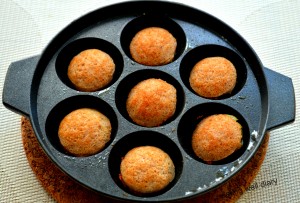

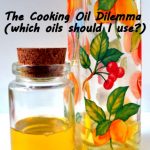
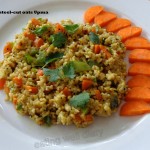
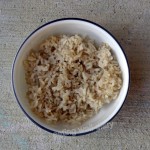

22 thoughts on : Tips On Cooking Vegetables and More
Apsara
This is a fabulous post! So informative and educating. I guess you have covered almost everything there…leaving no space for us to contribute ;)…
Cooking methods do co tribute to the food nutrition.
Lately, I am trying to use less and less of pressed oils be it vegetable oil or canola…their saturated and grand fats are high and these are practically nutrition deprived but then for ocassional deep frying, they make a convinient choice!!
Kudos! Well done there:)
Thank you so much, Sonal. Yes, I was also using organic canola oil till recently for deep frying, thinking it was healthy. But recently learned that all of canola oil is GMO, and that made me discontinue it. True, for occasional deep frying, one needs to use a cheaper product. After all budget does matter!
It is true that we can retain more nutrients when we wash the vegetables before we cut them? For e.g. cauliflower, potatoes(after peeling and before cutting), green beans etc. My dad used to insist that we should wash before, but not sure how much of that is true. Didn’t find anything in Google search.
Kshama, yes, experts say that most/all vegetables need to be washed thoroughly before cutting since the water-soluble vitamins can get washed away from inside the vegetable when the pieces are washed later.
Very informative post Apsara.. so useful!
Very informative post Apsara.. You have explained everything so well…I am saving it for further refrences.
My pleasure, Swati. I’m so glad you find it useful.
Superb post, Apsara. It has so many of the basics that we tends to forget. So much of the science behind our traditional practices is unsaid that these practices are just considered “old-fashioned” and discarded.
You cannot believe the reactions I get when I tell people I do not have a microwave.
My Vaidya also tells me to eat rice. The trick was to cook it the old-fashioned way and throw out the “ganji” (also used to starch clothes in olden days, nothing wasted you see). He told me not to pressure cook the rice.
Thank you so much Aruna. We are rediscovering the treasures of the past. Yes, with all the mixed reviews out there about microwaves, people do find us weird if we shun the method!
I have also wondered about the right method of cooking rice. Kudos to you for following the age-old way!
This is a great post. I love kitchen tips!
Thanks, Julie. Me too. ♥
Apsara,
Thank you so much for doing this post.
I know I had been requesting this and you answered most of my doubts.
This is good perspective and thank you for the web links as well.
Many a time, as we go after healthy food options, at least I consciously try to pursue it through cooking them in healthy medium. So real thanks.
My pleasure, Aparajita. I learned a lot while making this post. Do share any ideas that you find and I will update this post.
What a wonderful, useful and informative post, Apsara!! I learnt so many new things!! Saving this post and will share parts of it on my blog! Enjoy the rest of the weekend!
So glad you like it, Suchi. Feel free to share portions of it, I know you will give due credit. ♥
Great information. Thanks for sharing.
You’re welcome! Thank you for visiting.
Hi Aspara,
This post is a must-read! Thank you for sharing your valuable insights on healthy cooking methods with us at the Plant-Based Potluck Party! I too try to limit my oil consumption and I rarely fry. Thank you so much for sharing your gems and for your support! I’m pinning and sharing! All the best, Deborah
I’m very glad that you like this post, Deborah. Thank you for your support too.
That’s a great post! Thanks for Sharing!
Thank you for re-blogging it!
Pingback: Tips On Cooking Vegetables and More | foodbound